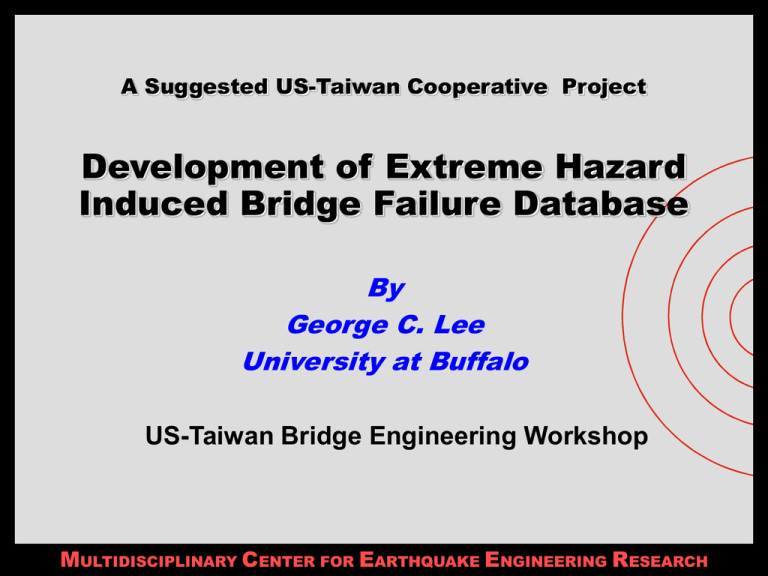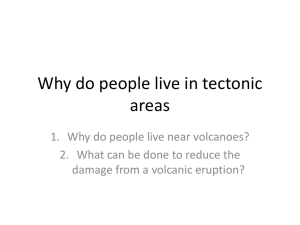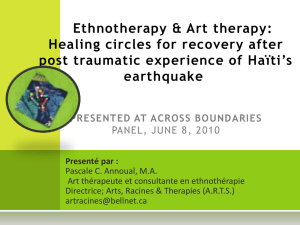Bridge Failure Database
advertisement

A Suggested US-Taiwan Cooperative Project Development of Extreme Hazard Induced Bridge Failure Database By George C. Lee University at Buffalo US-Taiwan Bridge Engineering Workshop MULTIDISCIPLINARY CENTER FOR EARTHQUAKE ENGINEERING RESEARCH Acknowledgement FHWA Project on Multi-hazard Studies Dr. P. Yen Program Manager Project Co-workers: Dr. E. Sternberg University at Buffalo Dr. M. Tong University at Buffalo MULTIDISCIPLINARY CENTER FOR EARTHQUAKE ENGINEERING RESEARCH Outline The Need To Consider Multihazards And Extreme Events The Need of A Platform For Hazards Assessment, Calibration and Comparison. A possible US-Taiwan Cooperative Project – Database For Earthquake and Hydraulic Hazards Summary MULTIDISCIPLINARY CENTER FOR EARTHQUAKE ENGINEERING RESEARCH Structural Design (LRFD) Capacity > Demand Safety Margin Is Provided By Using Strength Reduction Factors For Capacity And Overload Factors For Demand Various Uncertainties Involved In Establishing These Factors And In Their Proper Combinations MULTIDISCIPLINARY CENTER FOR EARTHQUAKE ENGINEERING RESEARCH Uncertainties Resistance Design Material Construction Maintenance Etc. Load Effects Conventional Loads Extreme Events Combinations Etc. MULTIDISCIPLINARY CENTER FOR EARTHQUAKE ENGINEERING RESEARCH Uncertainties Resistance Design Material Construction Maintenance Etc. Load Effects Conventional Loads Extreme Events Combinations Etc. Understand and Reduce Uncertainties in These Issues For Bridge Engineering Application MULTIDISCIPLINARY CENTER FOR EARTHQUAKE ENGINEERING RESEARCH Some Noted Bridge Failure in US.* 503 Cases of Bridge Failure Between 1989 and 2000 (12 years Period) Caused of Failure Difficult to Judge (Complex Interaction Between Load Effects And Resistance) Estimated 80+% of These Failures Are Primarily Due to Extreme Events * Wardhaua and Hadipriono (2003) MULTIDISCIPLINARY CENTER FOR EARTHQUAKE ENGINEERING RESEARCH Wardhaua And Hadipriono Study Externally Caused Failures (Extensive Loads) Hydraulic 52.88% Collision 11.73% Overload 8.75% Earthquake 3.38% Fire 3.18% Ice 1.99% Storm/Hurricane 0.4% 82.31% MULTIDISCIPLINARY CENTER FOR EARTHQUAKE ENGINEERING RESEARCH Bridge Failures Since 2003 2004 India Ocean Tsunami (Numerous Publications) 2005 Katrina Disaster (MCEER 2005, NIST 2006) Other Extreme Events Not Yet Documented/Published Strong Indication That Extreme Events Have Multihazard Features MULTIDISCIPLINARY CENTER FOR EARTHQUAKE ENGINEERING RESEARCH Bridge Failures Since 2003 2004 India Ocean Tsunami (Numerous Publications) 2005 Katrina Disaster (MCEER 2005, NIST 2006) Other Extreme Events Not Yet Documented/Published Strong Indication That Extreme Events Have Multihazard Features MULTIDISCIPLINARY CENTER FOR EARTHQUAKE ENGINEERING RESEARCH The Need For A Platform To Begin A Sustained And Organized Database Development Effort For Design Against Extreme Events Initial Phase To Establish Standardized Definitions And Ground Rules For Multihazard Extreme Events MULTIDISCIPLINARY CENTER FOR EARTHQUAKE ENGINEERING RESEARCH Categories Of Multihazard Extreme Events 1. 2. 3. 4. 5. Single Event Combined Multihazard Event Consequent Multihazard Event Subsequent Multihazard Event Simultaneous Multihazard Event Note: The above are listed in Approximate order from more to least likelihood of occurrence MULTIDISCIPLINARY CENTER FOR EARTHQUAKE ENGINEERING RESEARCH A Suggested US –Taiwan Cooperative Project On Bridge Engineering Development of Earthquakes and Hydraulic Hazards Database For Highway Bridges Scope: Emphasis given to bridge damage modes and related issues due to extreme events in selected regions. Express this information on an electronic platform according to a set of definitions and format to be established. MULTIDISCIPLINARY CENTER FOR EARTHQUAKE ENGINEERING RESEARCH Initial Thoughts On A Framework For Database Development Triggering Event Meteorological (Hurricane, Typhoons, Heavy Rain Fall) Geological (Earthquake) Combined, Consequent & Subsequent Multihazard Platform Induced Geomorphic and Hydrological Hazards Database Information Damage and Failure Modes of Highway (Standard) Bridges Due to Single Event, Combined, Consequent and Subsequent Multihazard Events MULTIDISCIPLINARY CENTER FOR EARTHQUAKE ENGINEERING RESEARCH Initial Thoughts On A Framework For Database Development Triggering Event Combined, Consequent & Subsequent Multihazard Platform Meteorological (Hurricane, Typhoons, Heavy Rain Fall) Geological (Earthquake) Induced Geomorphic and Hydrological Hazards Database Information Damage and Failure Modes of Highway (Standard) Bridges Due to Single Event, Combined, Consequent and Subsequent Multihazard Events MULTIDISCIPLINARY CENTER FOR EARTHQUAKE ENGINEERING RESEARCH Earthquake Liquefaction Landslide Tsunamis ? Storm Surge ? Severe Wind &/Or Rain Storm Load Effects on Bridges Debris Flow Scour River Flooding Vessel Collision MULTIDISCIPLINARY CENTER FOR EARTHQUAKE ENGINEERING RESEARCH Bridges There are many ways to classify bridges according to Material Construction Method Structural Type Crossing Method Span and Total Length Etc. MULTIDISCIPLINARY CENTER FOR EARTHQUAKE ENGINEERING RESEARCH Bridges There are many ways to classify bridges according to Material Construction Method Structural Type Crossing Method Span and Total Length Etc. • Concrete • Prestressed Concrete • Steel • Aluminum • Wood • Stone • Etc. MULTIDISCIPLINARY CENTER FOR EARTHQUAKE ENGINEERING RESEARCH Bridges • Integral constructed bridge There are many ways to classify bridges according to Material Construction Method Structural Type Crossing Method Span and Total Length Etc. • Segmental constructed bridge MULTIDISCIPLINARY CENTER FOR EARTHQUAKE ENGINEERING RESEARCH Bridges There are many ways to classify bridges tobridge Simpleaccording supported beam Material • Girder Continuous beam bridge Cantilever beam bridge • Truss Construction Method • Rigid frame Deck bridge Structural Type • Arch Half through bridge Crossing Method Through bridge • Cable-stayed Span and Total Length • Suspension Etc. • Combined system • Etc. MULTIDISCIPLINARY CENTER FOR EARTHQUAKE ENGINEERING RESEARCH Bridge Components Superstructure Deck system, cable, tower, upright column, suspenders, arch rib, wind brace Connections: bearing Substructure: pier, abutment Foundation Shallow: Spread foundation Deep: Pile foundation Etc. MULTIDISCIPLINARY CENTER FOR EARTHQUAKE ENGINEERING RESEARCH Initial Thoughts On A Framework For Database Development Identify Key Parameters for Hazard Comparison Methodology To Evaluate and Compare Multi-Hazards Load Effects On Bridges MULTIDISCIPLINARY CENTER FOR EARTHQUAKE ENGINEERING RESEARCH Initial Thoughts On A Framework For Database Development Development of Multihazard Design Approaches and Procedures MULTIDISCIPLINARY CENTER FOR EARTHQUAKE ENGINEERING RESEARCH Summary Multiple hazard design of highway bridges is a complex problem. In order to carry out a systematic study to evaluate and compare the extreme hazard load effects on bridges, a uniform methodology is needed, and calibrated with real-world data. Database may be developed by international partnerships. MULTIDISCIPLINARY CENTER FOR EARTHQUAKE ENGINEERING RESEARCH








